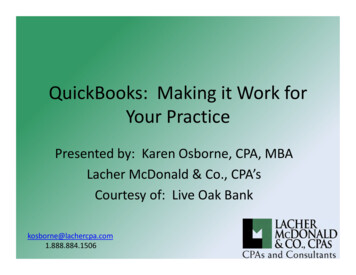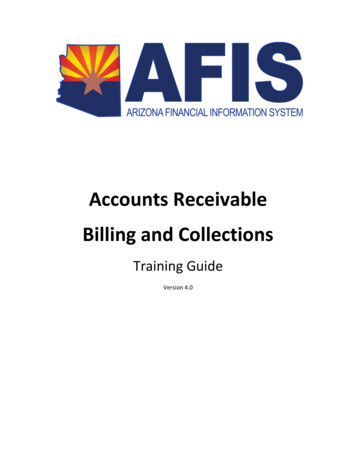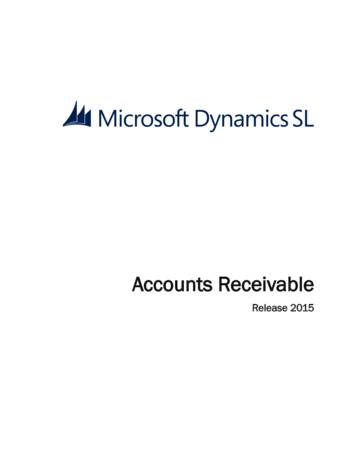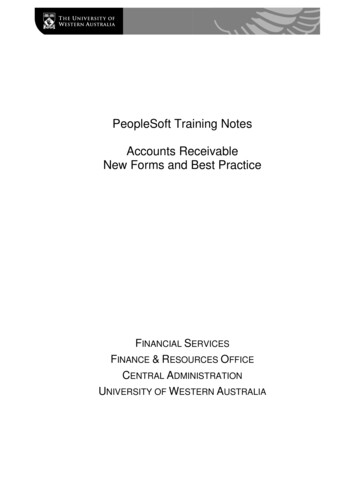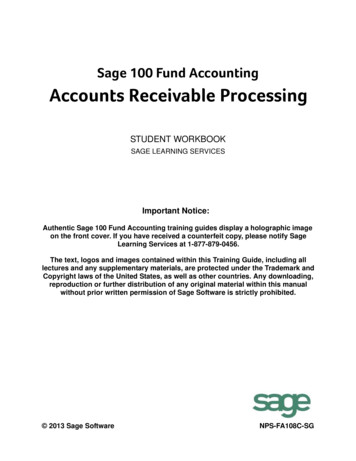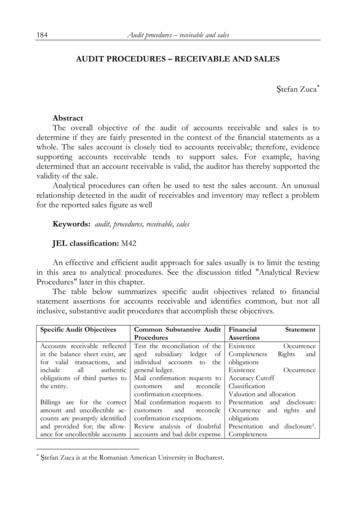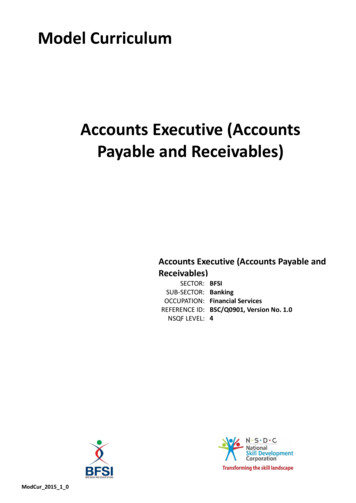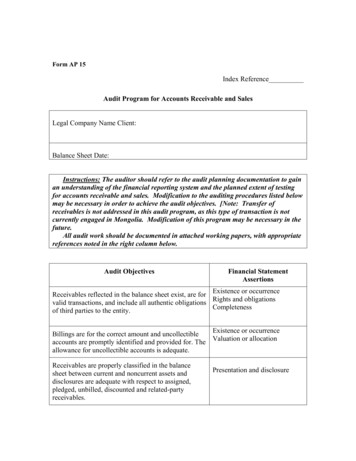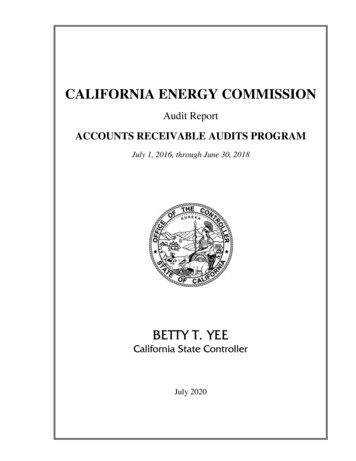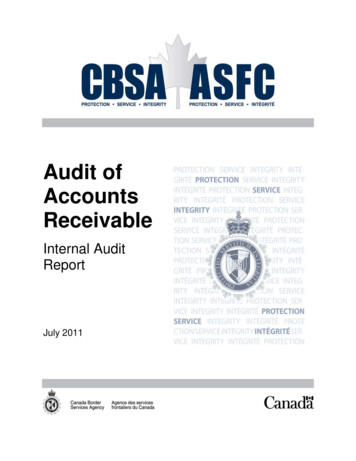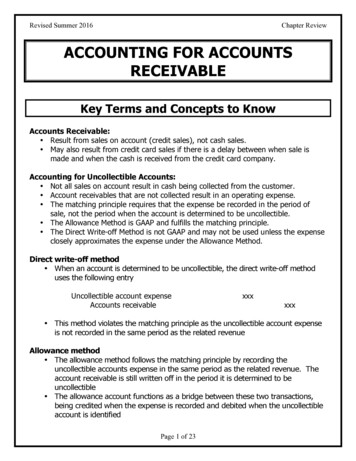
Transcription
Revised Summer 2016Chapter ReviewACCOUNTING FOR ACCOUNTSRECEIVABLEKey Terms and Concepts to KnowAccounts Receivable: Result from sales on account (credit sales), not cash sales. May also result from credit card sales if there is a delay between when sale ismade and when the cash is received from the credit card company.Accounting for Uncollectible Accounts: Not all sales on account result in cash being collected from the customer. Account receivables that are not collected result in an operating expense. The matching principle requires that the expense be recorded in the period ofsale, not the period when the account is determined to be uncollectible. The Allowance Method is GAAP and fulfills the matching principle. The Direct Write-off Method is not GAAP and may not be used unless the expenseclosely approximates the expense under the Allowance Method.Direct write-off method When an account is determined to be uncollectible, the direct write-off methoduses the following entryUncollectible account expenseAccounts receivablexxxxxx This method violates the matching principle as the uncollectible account expenseis not recorded in the same period as the related revenueAllowance method The allowance method follows the matching principle by recording theuncollectible accounts expense in the same period as the related revenue. Theaccount receivable is still written off in the period it is determined to beuncollectible The allowance account functions as a bridge between these two transactions,being credited when the expense is recorded and debited when the uncollectibleaccount is identifiedPage 1 of 23
Revised Summer 2016Chapter ReviewDetermining the Amount of Uncollectible Receivables and Bad Debt Expense: Percent of Sales Methodo Uses credit sales for the period to estimate bad debt expense for the period.o Sometimes referred to as the income statement method. Percent of Receivables Methodo Analyses the balance in Accounts Receivable to estimate the balance in theAllowance for Uncollectible Accounts at the end of the period.o Sometimes referred to as the balance sheet method.Collection of an account receivable previously written off Two journal entries to record subsequent customer payment: one to re-establishthe account receivable and the second to record the receipt of cashAccounts Receivable on the Balance Sheet: Net Realizable Value balance of Accounts Receivable less balance of AllowanceaccountAccounts Receivable Turnover and Average Collection Period Ratios All turnover ratios have the same format:Income statement account balanceAverage balance sheet account balance Therefore Accounts Receivable Turnover ratio is:Net credit salesAverage net accounts receivable Average Collection Period is:365Accounts receivable TurnoverPage 2 of 23
Revised Summer 2016Chapter ReviewKey Topics to KnowAllowance MethodThe Allowance Method takes its name from the Allowance for Uncollectible Account thatis used to properly value accounts receivable until the uncollectible account receivablecan be written-off.The Allowance Method debits bad debt expense in the period when the sale is recordedand credits a contra-asset account, Allowance for Uncollectible Accounts.Uncollectible Accounts ExpenseAllowance for UncollectibleAccountsxxxxxxIn the period in which a specific account is determined to be uncollectible, the Allowanceis debited and Accounts Receivable is credited.Allowance for Uncollectible AccountsAccounts ReceivablexxxxxxUncollectible Accounts Expense is reported on the Income Statement. The Allowance forUncollectible (Doubtful) Accounts is a contra asset account and is reported on theBalance Sheet as a deduction from Accounts Receivable. The result is called NetRealizable Value:Current Assets:Accounts Receivableless allowance for doubtful accountsNet Realizable Value 25,0003,00022,000Sometimes a customer will pay the accounts receivable after it was written off.Recording the receipt of cash is always a two-step process: first, the account receivableis reinstated (added back into the general ledger) and second, the cash is recorded andaccounts receivable is reduced for the payment.Page 3 of 23
Revised Summer 2016Chapter ReviewTo reinstate the accounts receivable:Accounts ReceivableAllowance for UncollectibleAccountsxxxxxxTo apply the cash received:CashxxxAccounts ReceivablexxxExample #1C Company provided the following information related to its accounts receivable:Last year12/31Currentyear1/053/18Required:Estimated that 7,000 of accountsreceivable would become uncollectible.Wrote-off the 800 balance owed by JCompany and the 500 balance owed byF CompanyReinstated the account of J Company thathad been written off as Uncollectibleupon receipt of payment in fullJournalize the transactionsSolution #1Uncollectible Accounts ExpenseAllowance for Uncollectible Accounts7,000Allowance for Uncollectible AccountsAccounts Receivable-CampAccounts Receivable-Friends1,300Accounts Receivable-CampAllowance for Uncollectible Accounts800Cash800Accounts Receivable-CampPage 4 of 237,000800500800800
Revised Summer 2016Chapter ReviewMethods for Estimating the Uncollectible AmountIn the period of sale, the customer that eventually will not pay, the amount that will notbe paid and the period in which the customer’s account will become uncollectible cannotbe determined. Therefore, the uncollectible accounts expense must be estimated at theend of each accounting period.Percentage of Sales MethodThe Percent of Sales Method uses one income statement account, Sales, to estimate thechange in another income statement account, Bad Debt Expense, for the period. This isthe amount of the required adjusting entry. This method is typically used by businesseswith a large number of customers with relatively uniform accounts receivable balances.The balance in the Allowance account is the balance in the ledger before adjustmentplus the adjusting entry for bad debt expense.The bad debt expense for the period is calculated by multiplying the uncollectiblepercentage times the credit sales in the period to determine the uncollectible accountsexpense for the period. This will be the amount of the adjusting entry.Example #2Uncollectible accounts expense is estimated at ¼ of 1% of net sales of 4,000,000 forthe year. The current balance in Allowance for Doubtful Accounts is 300 credit.Required:a)b)c)What is the uncollectible accounts expense for the year?Prepare the adjusting entry to be made on December 31.What is the balance in Allowance for Doubtful Accounts afteradjustment?Page 5 of 23
Revised Summer 2016Chapter ReviewSolution #2a)4,000,000 * .0025 10,000b)Uncollectible Accounts ExpenseAllowance for Uncollectible Accountsc) 300 credit balance 10,000 additional credit 10,300 creditbalance10,00010,000Percent of Accounts Receivable MethodThe Percent of Receivables Method uses the balance in one balance sheet account,Accounts Receivable, to estimate the balance in another balance sheet account,Allowance for Uncollectible Accounts, at the end of the period.The adjusting entry for bad debt expense is the difference between the balance in theledger for the allowance account before adjustment and the estimated balance in theallowance account.The current balance of accounts receivable is analyzed by use of an aging schedule todetermine the desired ending balance for the Allowance for Doubtful Accounts. Theuncollectible accounts expense for the period is determined based on the current(unadjusted) balance in the Allowance, the desired ending balance in the Allowanceaccount and any write-offs of uncollectible accounts during the period.Allowance for Doubtful AccountsBeginning balanceWrite-offsSolve for bad debt expenseEnding balanceBad debt expense ending balance write-offs – beginning balanceHowever, if there have been more write-offs than expected, the balance beforeadjustment in the allowance account may be a debit:Page 6 of 23
Revised Summer 2016Chapter ReviewAllowance for Doubtful AccountsBeginning balanceWrite-offsSolve for bad debt expenseEnding balanceBad debt expense ending balance write-offs beginning balanceExample #3The balance of Allowance for Doubtful Accounts before adjustment at the end of theperiod is 400 debit. Based on an analysis of Accounts Receivable, it was estimated that 9,000 would become uncollectible.Required:a)b)c)Determine the uncollectible accounts expense for the year.Prepare the adjusting entry to be made of December 31.Determine the balance in Allowance for Doubtful Accounts afteradjustment.Solution #3a)Allowance for Doubtful AccountsBalance400Uncollectible accountsexpense ?Accounts receivablewritten-off 09,000 ending balanceUncollectible accounts expense 400 9,000 -0 9,400b)Uncollectible accounts expenseAllowance for doubtful accountsc) 9,000Page 7 of 239,4009,400
Revised Summer 2016Chapter ReviewDirect Write-off MethodThe Direct Write-off Method records uncollectible accounts expense in the period whenthe customer’s account is determined to be uncollectible. The entry to write-off theaccount receivable isUncollectible accounts expenseAccounts receivablexxxxxxThe Direct Write-off Method violates the matching principle because it does not matchrevenues and expenses in the same period.Page 8 of 23
Revised Summer 2016Chapter ReviewPractice ProblemsPractice Problem #1The F Company uses the allowance method is used to account for uncollectiblereceivables. It had the following transactions during the year:05/14Received 75% of the 20,000 balance owed by Webb Co., abankrupt business. Wrote off remainder as uncollectible.Reinstated the account of Zorn Co., which had been writtenoff in the preceding year as uncollectible. Received 5,225cash as full payment of Zorn’s account.Wrote off the 2,500 balance owed by Schmich, Inc. whichhad no assets.Based on an analysis of Accounts Receivable, it isdetermined that 11,500 will become uncollectible. Thebalance in Allowance for Doubtful Accounts on December 31prior to adjustment is 200 credit.06/2007/2712/31Required:a)b)c)d)Journalize the transactionsThe balance in Allowance for Doubtful Accounts after adjustment.The Net Realizable Value of Accounts Receivable if the balance ofAccounts Receivable is 62,000.Redo the entry for 12/31 and questions b) and c) if the percent ofsales method had been used to estimate uncollectible accountsexpense at the rate of ½ of 1% of net sales of 2,000,000.Page 9 of 23
Revised Summer 2016Chapter ReviewPractice Problem #2At the end of the year, two similar companies were in the process of calculating baddebt expense for the year. Each company had credit sales of 1,000,000 and a debitbalance in Allowance for Uncollectible Accounts of 2,000 before any year-endadjustment. The amount of accounts receivable written off during the year for bothcompanies was 8,000. The balance of Accounts Receivable is 180,000.A Company estimates that 5% of accounts receivable will not be collected over the nextyear. B Company estimates that 5% of credit sales will not be collected over the nextyear.Required: For each company, determine:a)The uncollectible accounts expense for the year.b)The adjusting entry to be made of December 31.c)The balance in Allowance for Doubtful Accounts after adjustment.Practice Problem #3During its first year of operations, G Company provides services on account of 250,000.By the end of the year, cash collections on these accounts total 130,000. The companyestimates that 10% of accounts receivable will be uncollectible at the end of the year.On March 13, G Company writes off a customer's account of 3,800. On June 3, thecustomer unexpectedly pays the 3,800 balance. G Company uses the allowancemethod.Required:a)b)c)d)e)Determine the uncollectible accounts expense for the year.Prepare the entries required on March 15 and June 3.The adjusting entry to be made of December 31.The balance in Allowance for Doubtful Accounts after adjustment.The net realizable value of the accounts receivablePage 10 of 23
Revised Summer 2016Chapter ReviewPractice Problem #4At the end of the year, Q Company has a balance in Allowance for UncollectibleAccounts of 200 (debit) before any year-end adjustment. The balance of AccountsReceivable is 15,000. Total sales were 280,000, of which 20,000 was in cash. Thecompany estimates that 5% of sales on account were not collected during the year.Required:a)b)c)Assuming that Q Company did not record any uncollectibleaccounts expense during the year, prepare the year-endadjustment for uncollectible accounts expense.What is the balance in the allowance account at year-end?What would have been the likely entry that created the 200debit balance in the allowance account?Practice Problem #5At the end of the year, W Company has a balance in Allowance for UncollectibleAccounts of 2,000 (debit) before any year-end adjustment. The balance of AccountsReceivable is 150,000. Total sales were 3,000,000. 12,000 of accounts receivablewere written off during the year. The company estimates that 5% of the endingaccounts receivable balance would not be collected during the year.Required:a)b)What is the balance in the allowance account at year-end?Assuming that Q Company did not record any uncollectibleaccounts expense during the year; prepare the year-endadjustment for uncollectible accounts expense.Page 11 of 23
Revised Summer 2016Chapter ReviewTrue / False Questions1.The Allowance for Uncollectible Accounts is a contra asset account representingthe amount of accounts receivable that the company does not expect tocollect.True False2.Under the allowance method, when a company writes off an account receivableas an actual bad debt, it records an expense.True False3.A credit balance in the Allowance for Uncollectible Accounts before adjustmentindicates that last year's estimate of uncollectible accounts was too high.True False4.The direct write-off method violates the matching principle.True False5.Even though the percentage-of-receivables method and the percentage-ofcredit-sales method use different accounts to estimate future uncollectibleaccounts, the amount of bad debt expense reported in the income statementwill always be the same under the two methods.True False6.From an income statement perspective, the percentage-of-credit-sales methodis typically preferable because it better matches the revenues (credit sales)with their related expenses (bad debts).True False7.From a balance sheet perspective, the percentage-of-receivables method istypically preferable because assets (net accounts receivable) are reportedcloser to their net realizable value.True False8.The best estimate for the amount of cash a company expects to collect from itsaccounts receivable is the face value of the receivables.True False9.When an uncollectible account receivable is written off, the amount of totalassets is unchanged.True FalsePage 12 of 23
Revised Summer 2016Chapter Review10. When a company receives payment from a customer whose account waspreviously written off, the customer's account receivable should be reinstated.True FalsePage 13 of 23
Revised Summer 2016Chapter ReviewMultiple Choice Questions1. The two methods of accounting for uncollectible receivables are the directwrite-off method and the:a) Percentage of receivables methodb) Aging of credit sales methodc) Interest methodd) Allowance method2. The Allowance for Doubtful Accounts has a debit balance of 1,000 at the endof the year (before adjustment), and uncollectible accounts expense isestimated at 2% of net sales. If net sales are 600,000, the amount of theadjusting entry to record the provision for doubtful accounts is:a) 1,000b) 13,000c) 11,000d) 12,0003. The Allowance for Doubtful Accounts has an unadjusted debit balance of 1,000 at the end of the year. Estimate uncollectible accounts are 10,000. Ifaccounts receivable are 600,000, the amount of the adjusting entry is:a) 10,000b) 11,000c) 9,000d) 16,0004. Allowance for Doubtful Accounts has a credit balance of 500 at the end of theyear (before adjustment), and an analysis of customers’ accounts indicatesdoubtful accounts of 11,500. Which of the following entries records theproper provision for doubtful accounts?a) Debit Uncollectible Accounts Expense, 11,000; credit Allowance forDoubtful Accounts, 11,000.b) Debit Uncollectible Accounts Expense, 12,000; credit Allowance forDoubtful Accounts, 12,000.c) Debit Allowance for Doubtful Accounts, 12,000; credit UncollectibleAccounts Expense, 12,000.d) Debit Allowance for Doubtful Accounts, 11,000; credit UncollectibleAccounts Expense, 11,000.Page 14 of 23
Revised Summer 2016Chapter Review5. If the direct write-off method of accounting for uncollectible receivables isused, what general ledger account is debited to write off a customer’s accountas uncollectible?a) Uncollectible Accounts Payableb) Accounts Receivablec) Uncollectible Accounts Expensed) Allowance for Doubtful Accounts6. Receivables are usually listed in ordera)b)c)d)Of liquidityOf the due dateOf the sizeAlphabetically7. Accounts Receivable Turnover measuresa)b)c)d)Number of days outstandingFair market value of Accounts ReceivablesThe efficiency of the accounts payable functionHow frequently during the year the Accounts Receivable are converted tocash8. The Number of Days Sales in Receivablesa)b)c)d)Measures the number of times the receivables turn over each yearIs Net Credit Sales divided by Average ReceivablesIs not meaningful and therefore not usedIs an estimate of the length of time the receivables have been outstanding9. Accounts receivable are reported on the balance sheet at theira)b)c)d)Fair market valuePresent valueNet realizable valueMaturity value10. When an account is written off under the allowance method thea) Uncollectible Accounts Expense account is debited.b) Accounts Receivable account is debited.c) Allowance for Doubtful Accounts is debited.d) Loss on Accounts Receivable account is debited.Page 15 of 23
Revised Summer 2016Chapter Review11. On June 1, L Company wrote off Green's 2,500 account using the allowancemethod. What effect will this write-off have on L Company's balance sheet?a) An increase to stockholders' equity and a decrease to liabilities.b) No effect.c) An increase to assets and an increase to stockholders' equity.d) A decrease to assets and a decrease to stockholders' equity12. On January 1, D Company had balances in Accounts Receivable and Allowancefor Uncollectible Accounts of 53,600 and 1,325, respectively. During theyear, D Company wrote off 1,465 in accounts receivable and determined thatthere should be an allowance for uncollectible accounts of 1,280 at December31. Bad debt expense for 2016 would be:a) 1,280.b) 1,465.c) 1,420.d) 1,140.13. At the beginning of the year, the balance in J Company’s Allowance forUncollectible Accounts was 31,800. During the year, the company wrote off 38,000 of accounts receivable. Writing off the bad debts would include a:a) Debit to Bad Debt Expense; credit to the Allowance for UncollectibleAccounts.b) Debit to Bad Debt Expense.c) Credit to the Allowance for Uncollectible Accounts.d) Credit to Accounts Receivable.14. The allowance method based on the idea that a given percent of a company'scredit sales for the period will be uncollectible determines:a) The bad debt expense for the periodb) The ending balance in the allowance for uncollectible accountsc) The beginning balance in the allowance for uncollectible accountsd) The amount of accounts receivable to be written off.15. A Company expects 5% of its newer accounts receivable to be uncollectibleand 20% of its older accounts to be uncollectible. If the company has 40,000of newer accounts and 5,000 of older accounts, the balance in the allowanceof uncollectible accounts should be:a) 3,000b) 10,500c) 42,000d) 0Page 16 of 23
Revised Summer 2016Chapter ReviewSolutions to Practice ProblemsPractice Problem #105/14 CashAllowance for Doubtful AcctsAccounts Receivable-Webb15,0005,00006/20 Accounts ReceivableAllowance for Doubtful AcctsCashAccounts Receivable5,22507/27 Allowance for Doubtful AcctsAccounts Receivable2,50012/31 Uncollectible Accounts ExpenseAllowance for Doubtful Accts11,500 – 200 credit balance 11,300a)11,500 (based on analysis of A/R)b)Accounts receivableLess: Allowance for doubtful accountsNet Realizable Value12/31 Uncollectible Accounts ExpenseAllowance for Doubtful Accts2,000,000 x .01 x .5 10,000a)10,200 10,000 200 credit balanceb)Accounts receivableLess: Allowance for doubtful accountsNet Realizable ValuePage 17 of 235,22520,0005,2255,2252,50011,30011,300 62,00011,500 50,50010,000 62,00010,200 51,80010,000
Revised Summer 2016Chapter ReviewPractice Problem #2Company Aa)Allowance for Doubtful AccountsBalance2,000Uncollectible accountsexpense ?Accounts receivablewritten-off 8,0009,000 ending balanceUncollectible accounts expense 9,000 8,000 2,000 19,000b)Uncollectible accounts expenseAllowance for doubtful accounts19,00019,000c) 9,000Company Bd)Allowance for Doubtful AccountsBalance2,000Uncollectible accountsexpense 50,0001,000,000 x .05Accounts receivablewritten-off 8,00040,000 ending balanceAllowance of Doubtful Accounts balance -2,000 50,000 – 8,000 40,000e)Uncollectible accounts expenseAllowance for doubtful accountsf) 40,000Page 18 of 2350,00050,000
Revised Summer 2016Chapter ReviewPractice Problem #3BalanceAccounts Receivable 0250,000Sales on account3,800Account reinstated130,000Cash collections3,800Accounts written-off3,800Cash collections 116,200Ending balanceAllowance for Doubtful AccountsBalance 03,800Accounts written-off3,800Account reinstated11,620Uncollectible accountsexpense 11,620Ending balance 116,200 x 10%a) 11,620 3,800Endingwritten-offBalance3,800 reinstatedPage 19 of 230 11,620BeginningExpensebalance
Revised Summer 2016b)3/156/3Chapter ReviewAllowance for Doubtful AcctsAccounts Receivable3,800Accounts ReceivableAllowance for Doubtful AcctsCashAccounts Receivable3,800Uncollectible accounts expenseAllowance for Doubtful Accts11,6203,8003,8003,8003,800c)6/311,620d) 11,620 116,200 x 10%e) Net Realizable Value 116,200 – 11,620 104,580Practice Problem #4a)Sales on account 280,000 – 20,000 260,000Uncollectible accounts expense 260,000 x 5% 13,000b)BalanceAllowance for Doubtful Accounts 20013,000 Year-end adjustment 12,800 Ending balanceUncollectible accounts expanseAllowance for Doubtful Acctsc)Allowance for Doubtful AcctsAccounts ReceivableTo write-off uncollectible accountsreceivablePage 20 of 2313,00013,000200200
Revised Summer 2016Chapter ReviewPractice Problem #5a)Allowance for uncollectible accounts balance 150,000 x 5% 7,500b)BalanceWrite-offsAllowance for Doubtful Accounts 2,00012,00021,500 Year-end adjustment 7,500 Ending balanceUncollectible accounts expanseAllowance for Doubtful AcctsPage 21 of 2321,50021,500
Revised Summer 2016Chapter ReviewSolutions to True / False Problems1.2.3.4.5.6.7.8.9.10.TrueFalse - writing off an account receivable has no effect onexpenses.False – a credit balance in the allowance account indicates theamount of accounts receivable considered uncollectible.TrueFalse - bad debt expense will typically differ between the twomethods.TrueTrueFalse - The best estimate for the amount of cash a companyexpects to collect is the net realizable value of its accountsreceivable.TrueTruePage 22 of 23
Revised Summer 2016Chapter ReviewSolutions to Multiple Choice ADDCCBCDAAPage 23 of 23
Accounts Receivable, to estimate the balance in another balance sheet account, . By the end of the year, cash collections on these accounts total 130,000. The company estimates that 10% of accounts receivable will be uncollectible at the end of the year. On March 13, G Company writes off a customer's account of 3,800. .

